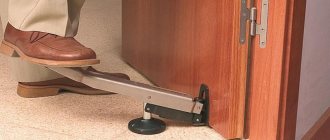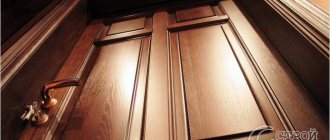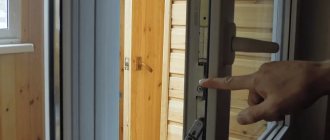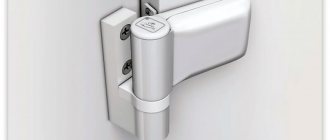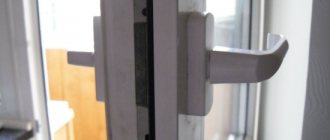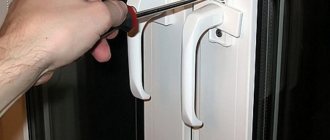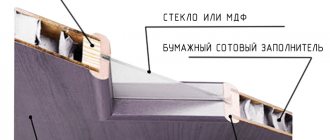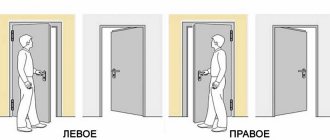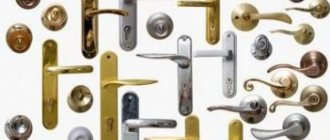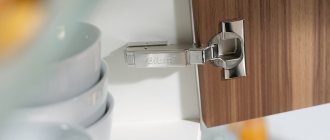A lot of my friends complain that there is a draft through the door, it doesn’t close tightly, and a bunch of other problems. I have to go and figure out what happened there.
In fact, there is only one reason - improper care of the fittings and rubber seals. Every time we have to explain what needs to be done, how to care for the door. In this regard, I decided to write instructions for everyone, in case you have the same problem and cannot find a solution.
How to independently adjust a plastic balcony door
Plastic windows and doors are an excellent option for apartments and houses. But they do not last forever, and it happens that problems arise with the balcony door. If this happens during the warranty period, professionals from the installer will deal with the problem completely free of charge. But after the warranty ends, repairs can be expensive. We will tell you how to properly adjust a plastic balcony door with your own hands and save money.
How to adjust plastic doors: identifying damage
After several years of operation, plastic balcony and entrance doors let cold air through, do not fit tightly, and jam when closing and opening. Self-adjustment eliminates malfunctions. Before starting repairs, determine the nature of the defect.
The doors let cold air through. To check the tightness of the structure, hold a sheet of paper between the frame and the door and lock it. Try to remove the sheet: if it gives in, the seal of the structure is broken.
Condensation on the windows is one of the signs of a seal problem. Source: https://ardexpert.ru/
The canvas clings to the box and creaks. The door opens and closes with interference, friction is noticeable. Adjusting plastic doors eliminates the defect: if it is not corrected in time, the profile will be damaged.
The doors sagged. Failure is detected during inspection of the structure. If a gap forms in the upper part of the door, and the lower part touches the threshold, this means that the canvas is sagging.
The handle wobbles or jams. In the first case, the cause of the defect is inaccurate operation, in the second - wear of the lock core, clogging or sagging of the door leaf.
The 3-way mechanism jams. The reason may be contamination of the part or its wear.
When the door needs adjustment
Balcony doors made of metal-plastic usually do not require preventive adjustment. If you have no complaints about how they work, then you don’t need to do anything.
But if you notice that the door is starting to function differently than it should, then this is a sure sign that adjustment is necessary.
The most common signs are the following.
- The sash touches with its lower part the edge of the frame, which serves as a threshold. This usually happens because the sash sags under its own weight. The glass unit makes up most of the mass of the sash. If you installed a double-chamber double-glazed window with 6 mm thick glass, then the hinges will “get tired” under such a place over time, causing the sash to move.
A gap in the upper corner is a sign of sagging door
Glass replacement
Instructions for replacing glass on a balcony door:
- Using a chisel, thin spatula or knife, remove the glazing beads. First the long one, then the rest in order of priority.
- Next, using a spatula or any other suitable tool, carefully pull out the glass.
- Next, insert the glass and place the support pads as in the diagram below.
- Carefully close the door and if no rubbing occurs, hammer in the glazing beads; if there is rubbing, then it is necessary to further adjust, you may need to additionally add support pads, in some places it is possible to have two at once.
We make the adjustment ourselves
Whatever the cause of the problem, you may need the following tools to fix it:
- hex keys of different sizes;
- screwdrivers - flat and Phillips;
- roulette;
- pliers;
- plastic gaskets.
Set of hex keys for adjustment
When sagging
If, when opening, the balcony door touches the frame with the lower edge of the sash, the sagging should be eliminated by adjusting it. To do this, the door leaf is “moved” up and shifted to its upper hinge.
- Open the sash in the swivel position (note, this is not the ventilation position).
- Using a 4 mm hex adjustment wrench, turn the screw near the top hinge at the end of the sash. Make a few turns to the right (clockwise) to tighten the sash. After that, close the door.
- Remove the decorative plastic caps from the bottom hinge. This will give you access to the top adjustment screw on the top end of the hinge.
- Turn it clockwise. The door will rise.
- Check the freedom of movement of the sash. If necessary, repeat the operation.
Adjustment on the top loop when sagging
Note! Some hardware systems are equipped with adjusting screws for an asterisk key, and not for a standard hexagon. If necessary, it is better to buy such a key in advance.
When touched in the middle part
In this case, the sash needs to be moved closer to the hinges.
- Move the sash towards the bottom hinge. Insert the adjusting key into the side adjusting screw and pull the sash in the direction of the hinge.
- If this is not enough, repeat the process for the top loop. We described its adjustment above.
Bottom Hinge Adjustment
Usually this procedure is enough for the sash to stop clinging to the frame.
Pressure adjustment
The pressing force of the door leaf to the frame is adjusted using locking elements. They are located on the sash itself. Most fittings are equipped with locking elements in the form of eccentrics. Rotate them using pliers or an adjusting wrench until the pressure is optimal.
To achieve greater efficiency, before the adjustment process, read the corresponding diagrams in the instructions or on the hardware manufacturer’s website.
It is usually recommended to adjust the pressure twice a year: in the winter, set a tighter pressure, in the summer - looser.
Handle adjustment
This is the simplest task that you can easily complete in a short time. A common problem with handles is that they become loose over time.
- Rotate the plastic cap at the base of the pen 90 degrees.
- Tighten the exposed screws with a screwdriver. Do this carefully so as not to damage the pen body.
- If the play does not disappear after tightening the screws, this may indicate a crack in the handle body. In this case, the handle needs to be replaced.
Procedure
To resolve the problem, you can call a specialist from any company that installs plastic windows. In this case, you will have to wait a few days for him, since they have working hours, and also pay for this service. There is another option. You can do everything yourself.
Photo 2. Instructions
Photo 2 clearly shows the entire operating procedure. Using one or another pressure lever, you yourself will eliminate the gap through which the wind blows.
Preventative measures for problems
It is very important to be able to correctly adjust balcony doors in case of problems. But it’s even more useful to know how to prevent these problems, or at least make sure you encounter them as little as possible.
- When choosing windows and balcony doors made of metal-plastic profiles, pay attention to the characteristics of the fittings. They must exactly match the weight of the door leaf. Most fitting systems from modern manufacturers allow the installation of sashes weighing up to 130 kg. Usually this is enough.
- The so-called microlift, or sagging compensator, will help prevent the sash from sagging due to its own weight. This detail is necessary for heavy door leaves with large dimensions or with a two-chamber package. The design of this element can be different: from a small lever on the side of the sash to a roller on its lower part.
- Install an opening limiter - a special support rail. This will help prevent the sash from jamming and sagging.
In addition, it will be useful to check the installation of the door. Please pay attention to the following parameters:
- how tightly the door is pressed against the frame profile around the perimeter;
- whether there is a vertical displacement of the sash;
- How static is the door leaf when in the open position.
If the installation of the plastic balcony door was carried out correctly, then you may need adjustment very soon.
Preventive measures
Typically, plastic balcony doors are adjusted independently when problems arise. There is no point in calling a specialist twice a year for an inspection: with the help of simple preventive measures you can prolong the uninterrupted operation of the structure.
To reduce the frequency of adjustments and reduce the overall load on structures, especially when it comes to heavy heat-insulating models, it is recommended:
- Order a microlift (sagging compensator), which will reduce the load on the door by raising it slightly when opening.
Install a closer that will ensure the door closes smoothly.
Install an opening limiter as a way to protect against jamming of the sashes.
The guarantee of trouble-free operation of the door structure is suitable fittings. Locks and hinges must be able to support the weight of the door. For standard balconies, devices designed for no more than 120 kg are sufficient.
Dust and dirt
In some cases, problems with the operation of the door are caused not by the device itself, but by dirt and dust that gets into it. This happens on unglazed balconies, especially if the climate is characterized by gusty winds. In such a situation, it is worth checking all sides of the door leaf, the locking mechanism and hinges. If liquid gets into metal parts, rust could form, which WD-40 can remove.
Adjustment of the door pressure can only be carried out if the rubber seal is in good condition. If it is heavily worn, it is useless to adjust the sash. It is unlikely that it will be possible to do without replacing the seal.
How to independently adjust a plastic balcony door: point adjustment
Every day, the door on the balcony is subjected to repeated opening and closing cycles. It is not surprising that over time, even reliable fittings fail. In case of insufficient pressure to the frame, jamming of the sash or incorrect response to the position of the handle, do not rush to contact the service department. The listed problems are solved by simple adjustment of the plastic balcony door, for which you do not have to be a professional. It is enough to have a hex key on hand and the knowledge gained after reading this manual.
Most problems with plastic balcony doors can be fixed on your own.
Replacing the seal
On average, the seal on a balcony door is replaced every 2 to 3 years, but a high-quality seal can last 5 years. The seals have different configurations, it is important to purchase an elastic band that will fit your door; to do this, you need to slightly remove the edge of the seal and cut off a few centimeters. Then take the cut sample and buy a similar one.
Seals are sold by the meter, it is worth taking with a small margin of 10-15%.
Instructions for replacing the seal:
- Remove the old seal.
- The groove is cleaned of dirt with an alcohol-containing solution.
- Next, insert the seal into the groove along the perimeter from the top corner.
- After passing the perimeter, cut off the edge of the elastic 10 mm larger and insert it into the groove so that it fits tightly with the beginning of the rubber cord.
Important!
You should not put the seal on the glue, otherwise cleaning the groove will be a problem the next time you replace it.
Features of door hardware
Before we look at how to adjust plastic balcony doors, let's understand their design and operating principle. The main components here are: double-glazed windows, a metal-plastic frame and tilt-and-turn fittings. The latter is responsible for opening, closing and tilting the sash.
Balcony fittings are a belt mechanism located along the perimeter of the door leaf. Control is carried out by a handle, the rotation of which leads to the movement of cylindrical locks relative to the counter plates installed on the fixed frame. The canvas is attached to the frame with special hinges that can carry the load created by a heavy metal-plastic frame with double-glazed windows.
Tilt and turn fittings are manufactured in such a way as to ensure convenient operation and simple setup. products For this purpose, the mechanism is equipped with several adjusting bolts, which allow:
- increase or decrease the pressure of the canvas to the frame;
- lower or raise the sash;
- adjust the horizontal position of the balcony door.
Location of adjustment elements for the plastic balcony door
Adjusting plastic doors yourself: instructions
Before you start adjusting the entrance or balcony plastic doors, check the integrity of the seal. Often its defects become the cause of drafts and leaks. If the seal is damaged, replace it with a new one. In this case, there is no need to disassemble and adjust the mechanisms.
Before starting repair work, close the doorway and outline the frame around the perimeter. The contour should be parallel to the inner edges of the door frame. If there are curvatures, you need to eliminate the sagging of the sash and adjust the canvas in height.
First remove the decorative trims from the hinges, this will provide access to the screws.
Door pressure adjustment
Loosely fitting doors lead to drafts in the house and the formation of condensation on the glass. Before you start adjusting the door pressure, you need to determine the place where the gap appears.
- Take a sheet of paper and insert it into the doorway.
- Open the sash, turn the handle.
- Start pulling out the leaf. If it does not give in, the sash fits tightly.
- Check each area around the perimeter.
If there are areas where the sashes do not fit tightly, you need to correct the defect by turning the axles. These are bushings at the end of the door frame, located along its perimeter. When the door opens and closes, they move.
On one side of the pins there is a mark or a stamped point - this is a mark. It should be directed upwards. To make the clamp tighter, turn the axle with the hexagon mesh towards the room. So the door is switched to “winter” mode. To loosen the fit, turn the mechanism towards the street.
Adjust the position of the door using the pin and hinges. Source: https://www.okno-moskva.ru/
Problems with plastic doors and methods for eliminating them
Standard problems are solved by point adjustment. Almost all manufacturers produce plastic balcony doors using the same technology, so the mechanism settings are identical.
Pressure adjustment for insufficient sound and heat insulation
Plastic door and window structures are characterized by a high level of sound insulation and thermal insulation. If the sound from the street calmly penetrates into the room, and in winter it is also accompanied by a cold air flow around the perimeter of the seal, the owners are sinning on the quality of the design by making claims to the manufacturing company. Usually the manufacturer has nothing to do with it, and the problem arises due to weak pressing of the sash to the frame.
Depending on the hardware manufacturer, the appearance of the trunnions may vary slightly
Inside the trunnion there is a hole with six edges, which allows you to adjust the plastic balcony door with a hex key. If you turn the eccentric mostly towards the rubber seal, the pressure will be maximum, respectively, if with a smaller part - minimum. The difference between the extreme positions of the trunnion is 2 mm, so the effect is noticeable.
If desired, the eccentrics can be adjusted several times a year. In winter, set the maximum pressure, in summer the minimum, and in spring/autumn set the trunnion to the middle position.
Pressure adjustment depending on the season
The door to the balcony does not close well - it has sagged/sagged
A situation often arises when the door leaf rubs against the frame, which forces you to put more effort into closing the balcony. Adjusting the hinges (top or bottom) will help solve this problem.
The top hinge is equipped with an adjusting bolt, which can be reached by opening the sash 90°. Rotating the bolt clockwise causes the top edge of the blade to be pulled towards the loop. Accordingly, rotating the bolt counterclockwise causes the opposite effect - the upper edge moves away from the hinge.
Adjusting the hinge of a plastic balcony door is carried out with the same tool as adjusting the trunnions
The bottom hinge has the same screw to adjust the horizontal position of the bottom edge. In this case, adjustments can be made both from the outside and from the inside. In both cases, you need to rotate the screw with the door open and check its operation after every 2 turns.
The lower loop is most often adjusted from the inside, since the slope interferes with the outside
The lower hinge performs another function - it allows you to lower or raise the sash. A vertical screw located at the top of the mechanism is designed for this. To get to it, you must first remove the decorative trim. Rotating the screw clockwise raises the door leaf, and counterclockwise causes it to lower.
Vertical adjustment can be made when the balcony door is in locked position or tilt mode
In the process of adjusting the position of the sash, it is important to maintain balance, since if you eliminate a problem in one place, you can get it in another. It is advisable to immediately determine where exactly the canvas rubs against the frame and, based on this, adjust the upper or lower hinge.
Opening the door in two positions at once
Incorrect adjustment of the fittings can lead to the opening of the balcony door in two modes at once - rotary and inclined. This can happen in the following cases.
In tilt mode, the lower corner of the sash is not fixed
If, when you turn the handle up, the door leaf not only reclines to the ventilation mode, but also opens completely, most likely the bottom of the sash has shifted towards the hinge. At the bottom of the end on the handle side there is a special lock that fixes the angle in tilt mode. For it to work correctly, the lock must fit into the mate located on the frame. If the angle is excessively shifted, locking does not occur, and the door opens in any position of the handle.
To fix the problem yourself, adjust the bottom hinge of the balcony door. Following the technology described in the previous section, slightly remove the door leaf from the hinge, thereby bringing the “problem” corner closer to the counterpart of the lock.
For normal operation of the lock, a couple of millimeters may be missing, so you should check the result after each turn
In the rotation mode, the door tilts at the same time
The problem is the sagging of the door leaf, in which the pressing eccentric located on the scissors does not reach the counterpart and does not fix the upper corner in the rotary mode. Therefore, when the handle is in a horizontal position, the sash not only rotates, but also tilts.
The solution to the problem is simple. It is enough to lift the door slightly when closed so that the upper eccentric fits into the groove of the mating part and fixes the angle. The procedure is performed by adjusting the lower loop.
To eliminate unintentional tilt, just make a few turns clockwise
Adjusting the PVC door handle
How to tighten a loose handle in 1 minute:
The latch no longer holds
When the sash opens spontaneously when the sash is closed, the problem may not only be a malfunction of the latch mechanism. Perhaps the entire door is warped. First of all, you need to check its position in all planes using a level. If it is discovered that the structure is installed crookedly, it must be reinstalled.
If no violations are found in the installation, the problem may be that the sash is narrowed in the center. To eliminate this defect, you need to measure the width of the canvas in 3 places - top, bottom and middle. The results obtained should be the same. If this is not the case, the door will have to be reinstalled.
The next defect that can cause spontaneous opening is the curvature of the sash; the angles of the structure are not equal to 90°. When measuring with a square, all angles must be right, and if this is not the case, the door must be reinstalled.
If, after checking the geometric parameters, it turns out that there are no deviations, it is necessary to check the alignment of the latch elements on the sash and frame. When closed, the socket and tongue should be located on the same line strictly horizontally.
If the alignment is broken, it can be corrected with a screwdriver or screwdriver. To do this, any part of the locking device is raised or lowered, or both components of the mechanism are rearranged at once.
Self-service of plastic balcony doors
In order for the plastic balcony door to work properly for a long time, in addition to proper adjustment, periodically lubricate the seal and fittings. Manufacturers recommend lubricating these components at least once a year, before the start of the cold season.
Seal lubrication
The rubber seal can quickly dry out and crack if it is not lubricated in time. In addition, dry rubber often sticks to the plastic frame, which leads to an unpleasant sound when opening the sash.
The procedure is carried out using silicone lubricant, after first cleaning the rubber from dirt and debris. Liquid silicone is applied to a dry surface with a sponge or soft cloth. Some craftsmen use an aerosol for such purposes. However, in this case, the consumption will be an order of magnitude higher, since part of the material will be sprayed in vain, settling on furniture and interior items.
The best option for lubricating the rubber seal is a container with a foam tip.
Lubricating hardware
Sticking of the opening/closing mechanism is often caused by insufficient lubrication of the fittings. For such purposes, it is most convenient to use WD-40 lubricant, which has high penetrating ability. Lubricate all the locks located around the perimeter of the door leaf, including the main mechanism to which the handle is attached. Also pay attention to scissors and loops.
After lubricating, close the door and turn the handle several times to activate the lock mechanism. This will help the lubricant penetrate into remote corners.
The WD-40 container is equipped with a thin nozzle for spot lubrication in hard-to-reach places
What to do if the canvas touches the frame when opening
In this case, the door with its upper border can touch the frame. This indicates that, when adjusting the sagging, the sash was shifted to a greater height than necessary. It is easy to fix this problem: just turn the end screw once in the lower hinge. Sometimes the door cannot be closed completely, and the resulting gap allows cold air to pass through.
To avoid drafts, the sealing material should be changed. To do this, we purchase a suitable sealant at the construction market or in a store.
Using a screwdriver, release the groove from the old profile, then clean it of dried glue and wash it with a damp sponge or cloth.
Then you need to let the groove dry, then apply a layer of glue and attach the new profile with the fastening side. In this case, the cord or insulation material must not be pulled. It must be carefully smoothed out with your hands or a special copper tube with a curved end. The ends of the profile must be firmly glued.
So that balcony owners do not have to frequently change the sealing cord in the future, it is recommended to treat it with a special silicone mixture. You can usually purchase silicone for lubrication from the supplier of the balcony block system.
The handle for the plastic balcony door deserves special attention.
Deformation of locks and fittings is a fairly common problem. Sometimes, the door handle does not make a full rotation and requires force to do so.
Such a malfunction can be eliminated by using horizontal door adjustment. In this case, you can specifically press the door leaf more tightly in the direction opposite to the hinges before the start of the cold season. This is fine.
However, in the spring it is better to reduce the force of the pressing sash mechanism, since this causes it to break faster and also wears out the sealing profile. In situations where the handle is severely damaged, it is better to replace the deformed structural element with a new one.
If the handle is loose and turns too easily, you need to rotate the bar at the base 90 degrees. There are screws underneath that need to be tightened. This simple procedure will quickly solve the problem.
More on the topic What you need to know before insulating a loggia and balcony with your own hands
In order to check whether the balcony door has been adjusted correctly, let’s try to close the sash. If this happens easily, with light pressure on the handle, then the adjustment has been completed correctly.
Cases in which adjustment is needed
A misaligned door frame always leads to unpleasant consequences. Sometimes it is necessary to call a qualified specialist to eliminate them. But in the vast majority of cases you can cope on your own. Therefore, we will figure out how to adjust plastic balcony doors with our own hands. But before we give step-by-step instructions, we list the most common malfunctions:
- Cold air passes through the vestibule areas.
- The door handle is tight or does not close completely.
- It takes a lot of effort to cover the canvas.
- The sagging frame clings to the box.
Fixing these problems takes no more than half an hour, so there is no point in postponing the work until later.
If a little time has passed since the installation of the structure, and it is under warranty, it is better to entrust the adjustment to specialists.
All components of the balcony door are adjusted with a hex key No. 4
Installation quality control
Naturally, how much time will pass before the first adjustment is necessary directly depends on the correct installation. A properly installed door should:
- Remain static in any position. Simply put, when opened to any amount, the sash should remain in place, not trying to slam shut or open.
- Adhere to the door frame tightly and evenly over the entire area.
- No backlash, that is, the sash should not “dangle on the awnings.”
Advice! To ensure that the balcony block lasts longer without breakdowns, check the above indicators after completing installation work.
Main elements of control mechanisms
To avoid confusion, let us explain the meaning of the special terms that we will use in the step-by-step instructions:
- Hinges are hinge elements at the top and bottom of the frame, rotating around which it opens.
- Trunnions are cylindrical bushings at the end of the door frame, located along its perimeter. They move when the handle is opened and closed.
- The counter (clamping) strips are metal stops. They are located on the box and engage with the trunnions.
What tools are needed for adjustment
To adjust balcony or entrance plastic doors, take the following tools.
- Hexagons with a diameter from 2.5 to 5 mm.
- Tape measure or centimeter.
- Phillips and flathead screwdrivers.
- Passages.
- Machine oil for lubrication of moving elements.
- Plastic linings.
We offer step-by-step instructions on how to set up a plastic door.
If you bought the door recently and the warranty period has not yet expired, contact the company that installed the door. They will carry out repair work for free.
How to adjust a plastic door on a balcony yourself
First of all, let’s make sure that the cause of the problem is a malfunction of the mechanisms. The malfunctions described above may occur due to failure of the rubber seal. If in winter it froze to the frame, and you sharply pulled the handle, damage cannot be avoided. Therefore, we visually check the integrity of the seal. If necessary, replace the rubber band with a new one.
If the problem is in the mechanical part, in order to provide access to the adjusting screws, remove the decorative trims from the hinges.
In the vast majority of cases, a No. 4 hex and a Phillips screwdriver are sufficient for the job. Less commonly, you may need a #3 hex wrench, sprockets, pliers, or a flat-head screwdriver.
Before starting work, we recommend that you pay attention to the relative position of the canvas and the box. This will avoid unnecessary actions and install the elements in the correct position. To do this, close the frame and outline its perimeter with a pencil. The resulting contour should be parallel to the inner edges of the door frame. If this is not the case, you need to adjust the plastic balcony doors yourself.
We will describe the procedure for dealing with common faults.
The canvas is sagging and catches the threshold
This problem is typical for wide, heavy structures with double-glazed windows. Additional load can be created by heavy bags hanging on the handle, or children who like to ride on the door wings. Often it is after this that they begin to sag.
The lower hinge allows you to lift the sash. We insert a hexagon into it from above and rotate it:
- clockwise - raise;
- counterclockwise - lower.
This helps with even sagging. If only one corner catches, it is necessary to eliminate the distortion.
To do this, we use the lateral adjustments of the upper and lower hinges. We rotate the screw with a hexagon: when turning to the right, the blade moves towards the key, to the left - in the opposite direction.
In the correct position, the outer contour of the balcony door and the inner frame should be parallel.
If the range of movement with the adjusting screws is not enough, the geometry of the PVC frame is corrected with pads under the glass unit. It is better to entrust this work to qualified specialists. They dismantle the glazing beads and install calibrated wedges according to the diagram. If the technology is not followed, the load on the glass is distributed unevenly, and it may burst.
The canvas touches the edge of the box or is not covered tightly
This problem can be encountered in the autumn-winter period if the fittings were moved away from the corner as much as possible. The frame deforms slightly and engages with the axles. To fix the problem, you need to move the sash horizontally. It is important to do this evenly and avoid distortion. The mechanism is adjusted in two places: on the upper and lower loop.
Before you adjust the plastic balcony door yourself, you need to open it completely. This will provide convenient access to the mechanisms.
Sequentially rotate the screws of the upper and lower hinges. We control the moment when the pins stop clinging to the door frame. After this, the adjustment can be stopped. But it is better to achieve a position in which both edges of the sash are equidistant from the inner edge of the installation box. This can be easily checked by tracing the outline of the closed canvas with a pencil.
Please note: the head of the upper adjustment screw may be located on the corner side or above the door leaf.
Causes of jamming
Some “reactive” owners try to slam the door behind them with a sharp jerk, managing to pull their hand out at the last moment. With some skill this can be done. But the trouble is that it is quite difficult to calculate the force with which it is necessary to sharply pull the door towards you in order for the latch to operate. A blow to the box may cause a loose or worn handle to fall down and trigger the door lock. So much for “jamming.”
If the door is jammed not because it was handled incorrectly, not because of a blow or a sharp slam, then the reasons should be sought in the malfunction of the locking or door hinge elements.
There are not many of them. It could be:
- activation of the lock mechanism when the door is opened for “ventilation”;
- broken door handle;
- distortion of the structure;
- freezing of the door in winter due to condensate accumulated between the frame and the seal.
None of these reasons are fatal. Simply, if the balcony door does not close or open, you need to try to find out the reason, and in no case try to force it back into a vertical position or jerk it open.
The design, although reliable, can break if too much force is used. It's still plastic.
Characteristics of door hardware
To understand how to set up a plastic door, you need to understand their operating principle and design. The door leaf consists of a metal-plastic frame and double-glazed windows, as well as tilt-and-turn fittings, which are responsible for the position of the door and its opening. In fact, the doors have the same design as PVC windows, but differ in size.
The fittings themselves are made in the form of a belt mechanism, which is installed along the perimeter of the canvas. A handle is installed to control this mechanism. When the handle is turned, the cylindrical locks move relative to the metal plates fixed to the frame. The door leaf is fixed to the frame using hinges. To ensure tight closure, the plastic door hinges must be adjusted. The fittings provide convenient door operation and adjustment.
For this purpose, the tilt and turn mechanism has adjusting bolts that are designed to:
- adjusting the degree of pressure of the door leaf to the frame structure;
- raising and lowering the door (if the plastic balcony door is sagging, you need to tighten the adjusting bolts);
- aligning the position of the canvas in the horizontal plane.
Seal wear
On sale you can find seals of various manufactures and prices. The German seal is of the highest quality; its service life can reach 15 years. Naturally, such material is more expensive than those that become unusable after 4-5 years.
When purchasing a seal that looks like a rubber cord, you should pay attention to ensure that the material does not have any damage or cracks.
Repairing plastic balcony doors whose seal has worn out involves a complete replacement of this material. To do this you need to do the following:
- We remove the deteriorated seal from the grooves of the door profile;
- Using a damp cloth, we clean the grooves, removing dirt, dust and glue residues from them;
- Leave for some time until the grooves are completely dry;
- Carefully lubricate the grooves with glue and place a new sealing cord there;
- During installation work, be sure to maintain the original shape of the material, avoiding compression and stretching;
- We glue the joints formed in the corner of the profile;
- In order to extend the shelf life of the product, it can be coated with a special lubricant.
Common faults with PVC balcony doors
Any problems with PVC door leaves can be solved by point adjustment of plastic doors. Since all metal-plastic doors and windows are made using the same technology, the settings and adjustments of the mechanisms are the same for all manufacturers.
Adjusting the clamping mechanism
Most often, the adjustment of a plastic balcony door is made when the degree of pressure applied to the leaf is insufficient, which is why the sound and heat insulation characteristics of the enclosing structure deteriorate. To press the canvas along its perimeter, trunnions are installed. These are special eccentrics of a cylindrical configuration. They are mounted on the vertical end of the door. One axle stands on the upper end of the leaf, namely on the scissor mechanism, which fixes the sash in an inclined position.
At the end of each trunnion there is a hexagonal recess located slightly off-center. It is needed for adjustment using a hex key.
There are the following trunnion installation modes:
- If the eccentric is turned towards the seal with the wider part of the end (relative to the location of the recess), then the sash will be pressed as tightly as possible. This situation is also called “winter”.
- The “summer” position of the eccentric is ensured by turning the trunnion with its narrow part towards the seal. The gap with this position of the eccentric increases by 2 mm, which significantly affects the tightness of the blade.
- In autumn and spring, the eccentric is moved to the middle position, in which the widest and narrowest part is located strictly vertically.
Door not closing tightly
If the balcony door does not close well, it means it has sagged. In this case, you need to know how to lift a plastic balcony door. Since the door leaf rubs against the frame in such a situation, more effort is required to close the door. By adjusting the canopies (hinges) of plastic doors, you can solve the problem of sagging of the door leaf.
To do this, do the following:
- There is an adjustment bolt on the top hinge. To get to it, you need to open the sash at a right angle to the frame. If you start to rotate the bolt clockwise, the upper edge of the door will be pressed more tightly against the hinge. When rotating in the opposite direction, the upper edge of the canvas will move away from the canopy.
- The bottom hinge adjustment screw allows you to adjust the position of the bottom edge of the sash. It is located in the lower side part of the hinged structure. Its adjustment can be made from the outside or inside of the loop. In any case, the screw is rotated in the open position of the sash. After completing two turns, you need to check the operation of the canvas.
- By adjusting the bottom hinge, the entire sash can be raised or lowered. For this purpose, the hanging system has a vertically located screw. It is located at the top of the structure. But you can see this screw only after you remove the decorative trim. If the screw is rotated clockwise, the blade will rise. To lower the door, turn the screw counterclockwise.
When adjusting the position of the door leaf, it is important not to overdo it, because if you get rid of sagging on one side, you can get the same trouble on the other side. You need to carefully understand where the sash rubs against the frame structure, and adjust the upper or lower canopy.
On a note! After turning the adjusting bolt two turns, you can understand in which direction to carry out further work.
The door leaf opens in two directions
If the fittings are not configured correctly, the door leaf can open simultaneously in an inclined and rotary position.
Moreover, this can happen in two cases:
- When opening for ventilation, the lower corner of the door is not fixed. If the handle is turned up, the sash simultaneously tilts into ventilation mode and opens completely, that is, it is fixed only at one lower point. This happens if the canvas at the bottom moves towards the loop. This is due to the fact that the lock on the opposite side does not fit into the mate on the frame. To solve the problem, you need to adjust the lower hinge as described above. It is necessary to move the door slightly away from the hinge so that the non-locking corner fits the mating part of the lock.
- When the door is opened, its upper part simultaneously tilts forward, as in ventilation mode. The problem occurs due to subsidence of the canvas. In this case, the pin on the scissors does not fit into the mating part on the frame and does not secure the upper edge of the door. To fix the problem, the sash needs to be slightly raised in the closed position. Then the eccentric will fit into the groove of the lock and secure the top of the door. To do this, you need to adjust the bottom loop (how to do this is written above).
Handle adjustment
To tighten a loose handle, do the following:
- using a flat screwdriver, pull the decorative rectangular trim at the base of the handle towards you and turn it 90 degrees;
- as a result, the heads of the fasteners are exposed, which need to be tightened well using a flat-head or Phillips-head screwdriver;
- after that we install the decorative trim in its original place;
- We check the functionality of the handle.
Repairing a loose handle and lock
The cause of this problem is the loosening of the mounting screws located under the handle cover. Fixing the defect is simple:
- Pull the plate slightly towards you and rotate it 90° around its axis.
- Below the trim are Phillips screws. Screw them in with a screwdriver.
- Place the decorative piece in place.
If the lock malfunctions, the handle must be completely unscrewed along with the core. Clean and lubricate the mechanism, check functionality with a key. If everything is in order, install the device back. It is better to replace a broken lock with a new one.
Regular maintenance of PVC doors
In order for the PVC door leaf and fittings to last as long as possible, you need not only to adjust them correctly, but also to periodically lubricate the mechanisms, clean them of dirt and take care of the seals.
Advice! It is advisable to carry out maintenance of a plastic door once a year. It is especially important to do this before the start of the cold season.
Lubricating hardware
If the fittings are poorly lubricated, the opening and closing mechanism may jam. To lubricate it, it is better to use a special composition WD-40, which penetrates well into all mechanisms. Apply this lubricant to all locking eccentrics installed around the perimeter of the blade, as well as the locking mechanism of the handle. Pay special attention to the processing of loops and scissors.
After processing all the fittings, close the blade and twist the handle to activate the locking mechanism. Thanks to these actions, the lubricant will penetrate into all remote areas of the fittings.
What can I do to close it tightly?
If it blows from under the door, it means that the function of pressing it to the frame is broken. To eliminate the defect, perform frontal adjustment of the eccentrics. Changing their position by turning makes it possible to change the degree of pressure of the door to the frame. For the upper part it is possible to adjust by rotating the trunnion, for the lower part - with a screw located on the side edge of the canopy.
Scheme of actions for adjusting the pressure at the bottom of the door:
- Release the hinges from the decorative protection.
- Open the door. Press the blocker against the seal.
- Pull back the top of the door leaf to provide access to the eccentrics.
- Turn the screw to adjust the desired degree of pressure.
- For preventive maintenance, lubricate moving parts.
- Press the lock, set the sash to its original position.
- To increase the pressure, turn the eccentrics to the maximum level, for which lower the locking bolt, move the elements, tighten the fastening.
